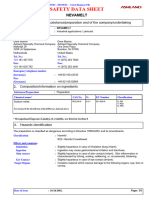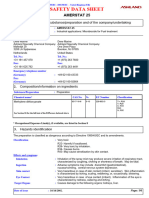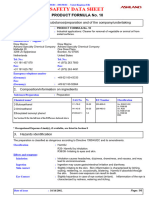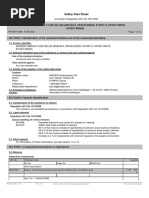5481 D9u7c5kub
5481 D9u7c5kub
Uploaded by
Nandar Min HtetCopyright:
Available Formats
5481 D9u7c5kub
5481 D9u7c5kub
Uploaded by
Nandar Min HtetOriginal Title
Copyright
Available Formats
Share this document
Did you find this document useful?
Is this content inappropriate?
Copyright:
Available Formats
5481 D9u7c5kub
5481 D9u7c5kub
Uploaded by
Nandar Min HtetCopyright:
Available Formats
Conforms to 91/155/EEC - 2001/58/EC - United Kingdom (UK)
SAFETY DATA SHEET
DREWCLEAN 2000
1. Identification of the substance/preparation and of the company/undertaking
Product name : DREWCLEAN 2000
Material Uses : Industrial applications: Quick separating degreaser.
Manufacturer / Supplier :
Drew Marine Drew Marine
Ashland Specialty Chemical Company Ashland Specialty Chemical Company
Malledijk 20 One Drew Plaza
3208 LA Spijkenisse Boonton, NJ 07005
Netherlands United States
Tel. No.: Tel. No.:
+31 181 457 070 +1 (973) 263 7600
Fax: Fax:
+31 181 625 792 +1 (973) 263 4491
Emergency telephone number
(Germany) : +49 621 60-43333
Fax:
(Germany) : +49 621 60-92664
2. Composition/information on ingredients
Substance/Preparation : Preparation
Chemical name* CAS No. % EC Number Classification
Low boiling point hydrogen treated naphtha; heavy 64742-48-9 80-90 265-150-3 Xn; R65
R66
Terpene hydrocarbons (mixture) 1-5 Xi; R38
(R)-p-Mentha-1,8-diene 1-5 227-813-5 R10
Xi; R38
R43
N; R50/53
See Section 16 for the full text of the R Phrases declared above
* Occupational Exposure Limit(s), if available, are listed in Section 8
3. Hazards identification
The preparation is classified as dangerous according to Directive 1999/45/EC and its amendments.
Classification : Harmful, Dangerous for the environment
R43- May cause sensitization by skin contact.
R51/53- Toxic to aquatic organisms, may cause long-term adverse effects in
the aquatic environment.
R65- Harmful: may cause lung damage if swallowed.
R66- Repeated exposure may cause skin dryness or cracking.
Effects and symptoms
Inhalation : Slightly hazardous in case of inhalation.
Ingestion : Slightly hazardous in case of ingestion.
Skin contact : Hazardous in case of skin contact (sensitizer).
Date of issue : 10/16/2002. Page: 1/5
DREWCLEAN 2000
4. First-aid measures
First-Aid measures
Inhalation : If inhaled, remove to fresh air. If not breathing, give artificial respiration. If
breathing is difficult, give oxygen. Obtain medical attention.
Ingestion : If swallowed, do NOT induce vomiting. Do NOT induce vomiting unless
directed to do so by medical personnel. Never give anything by mouth to an
unconscious person. Aspiration hazard if swallowed- can enter lungs and
cause damage. Loosen tight clothing such as a collar, tie, belt or waistband.
Obtain medical attention. Get medical attention if symptoms appear.
Skin contact : In case of contact, immediately flush skin copiously with water for at least 15
minutes while removing contaminated clothing and shoes. Wash clothing
before reuse. Clean shoes thoroughly before reuse. Obtain medical attention.
Eye Contact : Check for and remove any contact lenses. In case of contact, immediately
flush eyes with a copious amount of water for at least 15 minutes. Obtain
medical attention.
5. Fire-fighting measures
Extinguishing Media
Suitable : SMALL FIRE: Use dry chemical powder or CO2.
LARGE FIRE: Use water spray, fog or foam. Do not use water jet.
Hazardous thermal (de)composition : These products are carbon oxides (CO, CO2) and water.
products
Protection of fire-fighters : Fire fighters should wear self-contained positive pressure breathing apparatus
(SCBA) and full turnout gear.
6. Accidental release measures
Personal Precautions : Splash goggles. Full suit. Boots. Gloves. Suggested protective clothing
might not be sufficient; consult a specialist BEFORE handling this product.
Environmental precautions and : Keep away from heat. Keep away from sources of ignition. Stop leak if
cleanup methods without risk. Finish cleaning by spreading water on the contaminated surfac
and allow to evacuate through the sanitary system.
Note: See section 8 for personal protective equipment and section 13 for waste disposal.
7. Handling and storage
Handling : Keep away from heat. Keep away from sources of ignition. Ground all
equipment containing material. Do not breathe gas/fumes/vapour/spray. If
ingested, seek medical advice immediately and show the container or the
label. Keep away from incompatibles such as oxidizing agents.
Storage : Keep container in a cool, well-ventilated area. Keep container tightly closed
and sealed until ready for use. Avoid all possible sources of ignition (spark or
flame).
Packaging materials
Recommended use : Use original container.
8. Exposure controls/personal protection
Engineering measures : Provide exhaust ventilation or other engineering controls to keep the airborne
concentrations of vapours below their respective occupational exposure limits.
Ensure that eyewash stations and safety showers are close to the workstation
location.
Hygiene measures : Wash hands after handling compounds and before eating, smoking, using
lavatory, and at the end of day.
Occupational Exposure Limits
Date of issue : 10/16/2002. Page: 2/5
DREWCLEAN 2000
Ingredient Name Occupational Exposure Limits
Low boiling point hydrogen treated naphtha; heavy RPC (United Kingdom (UK), 2000). Notes: Supplier's
information
TWA: 1200 mg/m3
Respiratory system : Wear appropriate respirator when ventilation is inadequate.
Skin and body : Lab coat.
Hands : Impervious gloves.
Eyes : Safety glasses.
9. Physical and chemical properties
Physical state : Liquid.
Colour : Green.
Odour : Pleasant.
Boiling point : 177°C (351°F)
Melting point : <-20°C (-4°F)
Density : 0.78 to 0.8 g/cm3
Vapour density : >1 (Air = 1)
Vapour pressure : <0.29 kPa (<2.2 mmHg) (at 20°C)
Evaporation Rate : <1 compared to Ether (anhydrous).
Solubility : Insoluble in cold water.
pH : Not applicable.
Flash point : CLOSED CUP: >61°C (141.8°F).(Pensky-Martens.)
Autoignition temperature : The lowest known value is >200°C (392°F) (Low boiling point hydrogen
treated naphtha; heavy).
Lower explosion limit : The greatest known range is LOWER: 0.6% UPPER: 7% (Low boiling point
hydrogen treated naphtha; heavy)
10. Stability and reactivity
Stability : The product is stable.
Materials to avoid : Reactive with oxidizing agents.
Hazardous decomposition products : These products are carbon oxides (CO, CO2) and water.
11. Toxicological information
Acute toxicity
Ingredient Name Test Result Route Species
Low boiling point hydrogen treated naphtha; LD50 >2000 Oral Rat
heavy mg/kg
LD50 >2000 Dermal Rabbit
mg/kg
Terpene hydrocarbons (mixture) LD50 3500 mg/kg Oral Rat
LD50 >5000 Dermal Rabbit
mg/kg
(R)-p-Mentha-1,8-diene LD50 4400 mg/kg Oral Rat
LD50 5600 mg/kg Oral Mouse
LD50 >5000 Dermal Rabbit
mg/kg
Date of issue : 10/16/2002. Page: 3/5
DREWCLEAN 2000
Chronic toxicity : Repeated or prolonged exposure is not known to aggravate medical condition.
Sensitization : Hazardous in case of skin contact (sensitizer).
Carcinogenic effects : Not available.
Mutagenic Effects : Not available.
Reproduction toxicity : Not available.
12. Ecological information
Ecotoxicity Data
Ingredient Name Species Period Result
Low boiling point hydrogen treated naphtha; heavy Fish (LC50) 96 hours >100 mg/l
Persistence/degradability : Not available.
13. Disposal considerations
Methods of disposal ; Waste of : Waste must be disposed of in accordance with federal, state and local
residues ; Contaminated packaging environmental control regulations.
European Waste Catalogue (EWC) : 14 02 02
Hazardous Waste : The classification of the product may meet the criteria for a hazardous waste.
Additional Information : 14 02 02 solvent mixes or organic liquids free of halogenated solvents
14. Transport information
International transport regulations
Land - Road/Railway
UN number : Not regulated.
Proper shipping name : -
ADR/RID Class : -
Other information : Remarks
Not controlled under ADR (Europe).
Sea
UN number : Not regulated.
Proper shipping name : -
IMDG Class : -
Other information : Remarks
Not controlled under IMDG.
15. Regulatory information
EU Regulations
Hazard symbol(s) :
Harmful, Dangerous for the environment
Risk Phrases : R43- May cause sensitization by skin contact.
R51/53- Toxic to aquatic organisms, may cause long-term adverse effects in
the aquatic environment.
R65- Harmful: may cause lung damage if swallowed.
R66- Repeated exposure may cause skin dryness or cracking.
Date of issue : 10/16/2002. Page: 4/5
DREWCLEAN 2000
Safety Phrases : S23- Do not breathe vapour/spray.
S36/37/39- Wear suitable protective clothing, gloves and eye/face protection.
S38- In case of insufficient ventilation, wear suitable respiratory equipment.
S46- If swallowed, seek medical advice immediately and show this container
or label.
S56- Dispose of this material and its container at hazardous or special waste
collection point.
Contains : (R)-p-Mentha-1,8-diene 227-813-5
Product Use : Classification and labelling have been performed according to EU directives
67/548/EEC, 88/379/EEC, including amendments and the intended use.
- Industrial applications, Used by Spraying.
16. Other information
Full text of R-Phrases with no. : R10- Flammable.
appearing in Section 2 - United R38- Irritating to skin.
Kingdom (UK) R43- May cause sensitization by skin contact.
R50/53- Very toxic to aquatic organisms, may cause long-term adverse effects
in the aquatic environment.
R65- Harmful: may cause lung damage if swallowed.
R66- Repeated exposure may cause skin dryness or cracking.
Text of classifications appearing in : Xn - Harmful
Section 2 - United Kingdom (UK) Xi - Irritant
N - Dangerous for the environment.
HISTORY
Date of printing : 10/17/2002.
Date of issue : 10/16/2002.
Version : 3
DREWCLEAN® is a registered trademark of Ashland Inc.
Notice to Reader
To the best of our knowledge, the information contained herein is accurate. However, neither the above named supplier nor
any of its subsidiaries assumes any liability whatsoever for the accuracy or completeness of the information contained
herein.
Final determination of suitability of any material is the sole responsibility of the user. All materials may present unknown
hazards and should be used with caution. Although certain hazards are described herein, we cannot guarantee that these
are the only hazards that exist.
Date of issue Version
10/16/2002. 3 Page: 5/5
You might also like
- Standard Sds-Palmerol 1214-Lauryl-Myristyl AlcoholDocument8 pagesStandard Sds-Palmerol 1214-Lauryl-Myristyl AlcoholNatalia EstupiñánNo ratings yet
- 5483 Ahi7c5kubDocument5 pages5483 Ahi7c5kubNandar Min HtetNo ratings yet
- 4757 54a6c5kubDocument6 pages4757 54a6c5kubNandar Min HtetNo ratings yet
- 0057 M4t2c5kubDocument6 pages0057 M4t2c5kubNandar Min HtetNo ratings yet
- 0097 3s68c5kubDocument5 pages0097 3s68c5kubNandar Min HtetNo ratings yet
- 4139 Jo0mc5kubDocument6 pages4139 Jo0mc5kubNandar Min HtetNo ratings yet
- 4608 Vpmmc5kubDocument5 pages4608 Vpmmc5kubNandar Min HtetNo ratings yet
- 1295 1047c5kubDocument6 pages1295 1047c5kubNandar Min HtetNo ratings yet
- 0016 K1fkc5kubDocument6 pages0016 K1fkc5kubNandar Min HtetNo ratings yet
- 1269 5vp7c5kubDocument6 pages1269 5vp7c5kubNandar Min HtetNo ratings yet
- 6623 Cp4qc5kubDocument5 pages6623 Cp4qc5kubNandar Min HtetNo ratings yet
- 0063 6gtjc5kubDocument6 pages0063 6gtjc5kubNandar Min HtetNo ratings yet
- 0098 T8f8c5kubDocument5 pages0098 T8f8c5kubNandar Min HtetNo ratings yet
- 1266 9uh7c5kubDocument6 pages1266 9uh7c5kubNandar Min HtetNo ratings yet
- 0031 Ck14c5kubDocument5 pages0031 Ck14c5kubNandar Min HtetNo ratings yet
- 6519 K176c5kubDocument6 pages6519 K176c5kubNandar Min HtetNo ratings yet
- Safety Data Sheet: TECTYL 506 RAL 5008Document6 pagesSafety Data Sheet: TECTYL 506 RAL 5008sureshNo ratings yet
- 0091 Lpfvc5kubDocument5 pages0091 Lpfvc5kubNandar Min HtetNo ratings yet
- 1725 Hnu5c5kubDocument5 pages1725 Hnu5c5kubNandar Min HtetNo ratings yet
- 9534 G499c5kubDocument5 pages9534 G499c5kubNandar Min HtetNo ratings yet
- 6598 Gvecc5kubDocument6 pages6598 Gvecc5kubNandar Min HtetNo ratings yet
- 0058 Q1qgc5kubDocument5 pages0058 Q1qgc5kubNandar Min HtetNo ratings yet
- Vtrdc5kubDocument6 pagesVtrdc5kubNandar Min HtetNo ratings yet
- 1265 Tvtnc5kubDocument5 pages1265 Tvtnc5kubNandar Min HtetNo ratings yet
- 4064 Sjm6c5kubDocument5 pages4064 Sjm6c5kubNandar Min HtetNo ratings yet
- 0011 1550c5kubDocument5 pages0011 1550c5kubNandar Min HtetNo ratings yet
- 0048 3tn5c5kubDocument6 pages0048 3tn5c5kubNandar Min HtetNo ratings yet
- 1272 0s3cc5kubDocument5 pages1272 0s3cc5kubNandar Min HtetNo ratings yet
- 5 C 5 KubDocument6 pages5 C 5 KubNandar Min HtetNo ratings yet
- Peb6c5kubDocument6 pagesPeb6c5kubNandar Min HtetNo ratings yet
- 1274 N48uc5kubDocument6 pages1274 N48uc5kubNandar Min HtetNo ratings yet
- 0005 Ll64c5kubDocument6 pages0005 Ll64c5kubNandar Min HtetNo ratings yet
- 0082 Hvipc5kubDocument5 pages0082 Hvipc5kubNandar Min HtetNo ratings yet
- 1717 43eoc5kubDocument6 pages1717 43eoc5kubNandar Min HtetNo ratings yet
- 7c8tc5kubDocument5 pages7c8tc5kubNandar Min HtetNo ratings yet
- 1270 Lh7vc5kubDocument6 pages1270 Lh7vc5kubNandar Min HtetNo ratings yet
- 0007 Ok15c5kubDocument5 pages0007 Ok15c5kubNandar Min HtetNo ratings yet
- 99p9c5kubDocument5 pages99p9c5kubNandar Min HtetNo ratings yet
- D0tqc5kubDocument5 pagesD0tqc5kubNandar Min HtetNo ratings yet
- 4226 2p2mc5kubDocument6 pages4226 2p2mc5kubNandar Min HtetNo ratings yet
- 4907 Avkbc5kubDocument5 pages4907 Avkbc5kubNandar Min HtetNo ratings yet
- 0034 A2k4c5kubDocument6 pages0034 A2k4c5kubNandar Min HtetNo ratings yet
- 1259 P8e7c5kubDocument5 pages1259 P8e7c5kubNandar Min HtetNo ratings yet
- 0062 J5tfc5kubDocument5 pages0062 J5tfc5kubNandar Min HtetNo ratings yet
- 0026 Bgvac5kubDocument5 pages0026 Bgvac5kubNandar Min HtetNo ratings yet
- 9511 Lktjc5kubDocument5 pages9511 Lktjc5kubNandar Min HtetNo ratings yet
- 0089 Ei6uc5kubDocument5 pages0089 Ei6uc5kubNandar Min HtetNo ratings yet
- 0056 Fop5c5kubDocument6 pages0056 Fop5c5kubNandar Min HtetNo ratings yet
- 5247 Qahtc5kubDocument5 pages5247 Qahtc5kubNandar Min HtetNo ratings yet
- 1743 Tdjsc5kubDocument5 pages1743 Tdjsc5kubNandar Min HtetNo ratings yet
- 0076 Fi41c5kubDocument5 pages0076 Fi41c5kubNandar Min HtetNo ratings yet
- 1706 Hdtpc5kubDocument5 pages1706 Hdtpc5kubNandar Min HtetNo ratings yet
- 1731 78mtc5kubDocument5 pages1731 78mtc5kubNandar Min HtetNo ratings yet
- 9527 6m2cc5kubDocument5 pages9527 6m2cc5kubNandar Min HtetNo ratings yet
- 1213 28v5c5kubDocument5 pages1213 28v5c5kubNandar Min HtetNo ratings yet
- 0544 E1ifc5kubDocument5 pages0544 E1ifc5kubNandar Min HtetNo ratings yet
- Dip-It PlusDocument5 pagesDip-It PlusProsenjit76No ratings yet
- 1279 Srvmc5kubDocument6 pages1279 Srvmc5kubNandar Min HtetNo ratings yet
- 5482 3a11c5kubDocument4 pages5482 3a11c5kubNandar Min HtetNo ratings yet
- 1214 Lfp0c5kubDocument4 pages1214 Lfp0c5kubNandar Min HtetNo ratings yet
- 7266 Fq1hc5kubDocument5 pages7266 Fq1hc5kubNandar Min HtetNo ratings yet
- 2bhlc5kubDocument4 pages2bhlc5kubNandar Min HtetNo ratings yet
- 0572 Ku0cc5kubDocument5 pages0572 Ku0cc5kubNandar Min HtetNo ratings yet
- 9517 K87fc5kubDocument5 pages9517 K87fc5kubNandar Min HtetNo ratings yet
- 0651 Lb6gc5kubDocument5 pages0651 Lb6gc5kubNandar Min HtetNo ratings yet
- 0051 Strcc5kubDocument6 pages0051 Strcc5kubNandar Min HtetNo ratings yet
- 0041 Q6boc5kubDocument5 pages0041 Q6boc5kubNandar Min HtetNo ratings yet
- 403 Between and Among 260322Document24 pages403 Between and Among 260322Nandar Min HtetNo ratings yet
- 0036 6t5ec5kubDocument7 pages0036 6t5ec5kubNandar Min HtetNo ratings yet
- 21.1 Topic SUCCESS Lesson Notes-6Document1 page21.1 Topic SUCCESS Lesson Notes-6Nandar Min HtetNo ratings yet
- Kenshin Myanmar 3 Cross-Shaped ScarDocument140 pagesKenshin Myanmar 3 Cross-Shaped ScarNandar Min HtetNo ratings yet
- Adjectives Without Nouns-260322Document27 pagesAdjectives Without Nouns-260322Nandar Min HtetNo ratings yet
- Kenshin Myanmar 2 Legend of KyotoDocument137 pagesKenshin Myanmar 2 Legend of KyotoNandar Min HtetNo ratings yet
- Participle Clauses-260322Document34 pagesParticiple Clauses-260322Nandar Min HtetNo ratings yet
- Experiment and Experience-260322Document30 pagesExperiment and Experience-260322Nandar Min HtetNo ratings yet
- Kenshin Myanmar 1 Wandering SamuraiDocument170 pagesKenshin Myanmar 1 Wandering SamuraiNandar Min HtetNo ratings yet
- Material Safety Data Sheet: 1 Chemical Product and Company IdentificationDocument5 pagesMaterial Safety Data Sheet: 1 Chemical Product and Company Identificationmgsnxd2phzNo ratings yet
- GulfSea SuperBear 3006 2023 June 20 1CS23061-00 SGP EN 0Document9 pagesGulfSea SuperBear 3006 2023 June 20 1CS23061-00 SGP EN 0Semih AçmazNo ratings yet
- Safety Data Sheet Ethanol: NfpaDocument13 pagesSafety Data Sheet Ethanol: NfpaAngelicGamer Plays100% (1)
- SDS 40662 Jotashield Antifade Colours Euk TH-TH THDocument11 pagesSDS 40662 Jotashield Antifade Colours Euk TH-TH THBlack KnightNo ratings yet
- OMEGA FLUID SB 220 - Ficha de SegurançaDocument12 pagesOMEGA FLUID SB 220 - Ficha de Segurançahumbertohenrique212121No ratings yet
- Safety Data Sheet: SECTION 1: Identification of The Substance/mixture and of The Company/undertakingDocument7 pagesSafety Data Sheet: SECTION 1: Identification of The Substance/mixture and of The Company/undertakingMisterrriotNo ratings yet
- Journal of Phylogenetics & Evolutionary Biology: Sansevieria TrifasciataDocument7 pagesJournal of Phylogenetics & Evolutionary Biology: Sansevieria TrifasciataLevi Lou JuanNo ratings yet
- Section 01 - Product Information: Material Safety Data SheetDocument7 pagesSection 01 - Product Information: Material Safety Data SheetSofels FemiNo ratings yet
- Msds N Hexana PDFDocument6 pagesMsds N Hexana PDFMuhamadJaganurdinEl-SarawiNo ratings yet
- FORENSIC TOXICOLOGY MULTIPLE CHOICE QUESTIONS (MCQs PDFDocument20 pagesFORENSIC TOXICOLOGY MULTIPLE CHOICE QUESTIONS (MCQs PDFMINANI Theobald92% (13)
- 4b. Baker Hughes SUBSEA 136 SDSDocument10 pages4b. Baker Hughes SUBSEA 136 SDSwahab aliNo ratings yet
- FF6705 PDX 5W-40 enDocument7 pagesFF6705 PDX 5W-40 enBen E.No ratings yet
- Bioaccumulation and Toxicology For D2LDocument7 pagesBioaccumulation and Toxicology For D2Lจีทีเอส สุรเชษฐNo ratings yet
- Glucose LiquicolorDocument16 pagesGlucose LiquicolorAyahnyaFidelaFawniaNo ratings yet
- HDS - Inprosolve PC TM 240 KGDocument10 pagesHDS - Inprosolve PC TM 240 KGLina Maria RodriguezNo ratings yet
- Teroson WX 178 HPDocument14 pagesTeroson WX 178 HPedwin cNo ratings yet
- Eastman Turbo Oil 2380 - Canada - EngDocument13 pagesEastman Turbo Oil 2380 - Canada - Engdhavit wijayantoNo ratings yet
- Rust Blue Multi SDS GHS Rev 2Document10 pagesRust Blue Multi SDS GHS Rev 2trollforgeNo ratings yet
- Safety Data Sheet: Hempathane Topcoat 55219Document11 pagesSafety Data Sheet: Hempathane Topcoat 55219R irawanNo ratings yet
- SDS CX-100Document13 pagesSDS CX-100Hạnh DuyênNo ratings yet
- Chemical Disaster UnepDocument33 pagesChemical Disaster UnepVasant Kumar VarmaNo ratings yet
- Animal Testing Pros and ConsDocument6 pagesAnimal Testing Pros and ConsMalika SadridinovaNo ratings yet
- pdis 104Document32 pagespdis 104Biswaranjan SahooNo ratings yet
- Batuhan, Et Al 1 FINAL PRE ORALDocument16 pagesBatuhan, Et Al 1 FINAL PRE ORALAlna JaeNo ratings yet
- H0802ADocument12 pagesH0802AZoltars ButtNo ratings yet
- Leu - The Myths of Safe Pesticides 2014Document120 pagesLeu - The Myths of Safe Pesticides 2014flexionNo ratings yet
- Ucarcide 50Document7 pagesUcarcide 50Apri AstutiNo ratings yet
- Glycolic Acid SdsDocument11 pagesGlycolic Acid SdsJuthi RahmanNo ratings yet
- Microcare HDIDocument5 pagesMicrocare HDIdokterasadNo ratings yet









































































































